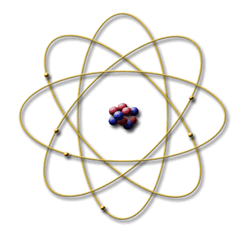Modern Atomic Theory: Models
 |
Bohr model |
In 1913, Neils Bohr, a student
of
- Electrons occupy only certain orbits around the nucleus. Those orbits are stable and are called "stationary" orbits.
- Each orbit has an energy associated with it. The orbit nearest the nucleus has an energy of E1, the next orbit E2, etc.
- Energy is absorbed when an electron jumps from a lower orbit to a higher one and energy is emitted when an electron falls from a higher orbit to a lower orbit.
- The energy and frequency of light emitted or absorbed can be calculated by using the difference between the two orbital energies.
 |
Quantum mechanical model |
In 1926 Erwin Schrödinger, an Austrian physicist, took the Bohr atom model one step further. Schrödinger used mathematical equations to describe the likelihood of finding an electron in a certain position. This atomic model is known as the quantum mechanical model of the atom. Unlike the Bohr model, the quantum mechanical model does not define the exact path of an electron, but rather, predicts the odds of the location of the electron. This model can be portrayed as a nucleus surrounded by an electron cloud. Where the cloud is most dense, the probability of finding the electron is greatest, and conversely, the electron is less likely to be in a less dense area of the cloud. Thus, this model introduced the concept of sub-energy levels.
Until 1932, the atom was believed to be composed of a positively charged nucleus surrounded by negatively charged electrons. In 1932, James Chadwick bombarded beryllium atoms with alpha particles. An unknown radiation was produced. Chadwick interpreted this radiation as being composed of particles with a neutral electrical charge and the approximate mass of a proton. This particle became known as the neutron. With the discovery of the neutron, an adequate model of the atom became available to chemists.
Since 1932, through continued experimentation, many additional particles have been discovered in the atom. Also, new elements have been created by bombarding existing nuclei with various subatomic particles. The atomic theory has been further enhanced by the concept that protons and neutrons are made of even smaller units called quarks. The quarks themselves are in turn made of vibrating strings of energy. The theory of the composition of the atom continues to be an ongoing and exciting adventure.